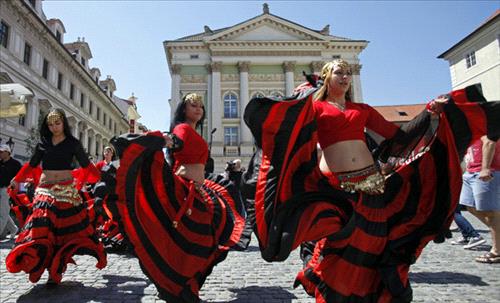Ammon News - By: Mohammad al Fdeilat Translated from As-Safir (Lebanon)/ Al-Monitor.
According to statistics, 70,000 Roma or ''gypsies” live in Jordan. They live in their own world, one that seems to be surrounded with high walls that prevent outsiders from getting in and their sons from getting out. Although they enjoy full citizenship rights, hold Jordanian passports and civil status cards, and fully exercise their constitutional rights, they are detached from the Jordanian society, refuse to integrate and remain enigmatic.
The presence of Roma in Jordan dates back nearly 250 years. According to historical accounts, the origins of the Roma go back to the Indian state of Behad. In the 5th century A.D., the king of Behad sent to his brother-in-law, the king of Persia, 10,000 singers and musicians along with their wives and children. It was at the request of the latter, who wanted to please his people by holding dance and singing concerts. The king offered them land, seed, and one donkey each. Because they indulged in dancing and singing, they neglected agriculture until the stock granted by the king ran out.
When they came back asking for more, he expelled them. As a result, an endless journey of dispersion and roaming began.
From the suburbs of India or Baniu Morra
According to historical accounts, the Roma migrated in three waves. The first wave traveled to the southwest towards the Levant, then to Egypt and North Africa. The second journeyed north to areas that make up today's Armenia and Georgia, while some continued to Greece. The third headed to Asia Minor, then to central and Western Europe, then to Portugal and Spain.
Jordan’s Roma reject this historical account and provide their own version, which says that they are pure Arabs who belong to “Bani Murra,” whom Zeer Salem avenged and ordered to be dispersed across the world. He also ordered that they never ride horses and or have comfort, security and stability, as has really been the case.
The Roma document the history of their continuous sorrow and roaming with a well-known chant they repeat: “I am the son of the wind and the sun … I am doomed to continuous roaming and eternal sadness … My mother, the wind, does not settle in any place and carries me with it … My mother, the sun, shines on a spot of land far away, shines over another, and then returns in an endless journey.” Their roaming is not over yet. However, borders have imposed their conditions. They were bound by the wind, and later became bound by the spaces that have not yet been cemented, which are sufficient for them to build their tents or “kharabeesh,” as they are called in Jordan.
On the walls of the Roma’s world
Through holes in the walls with which the Roma have surrounded their world, which is immersed in discretion, horoscope reading and occultism, seep features of the mythical world in which they live. There, nothing has changed since ancient times. Women continue to wear frilled, loose clothing and excessive jewelry of different styles. They also wear large silver earrings and let their black hair fall on both shoulders.
Women have not lost their ability to dance and sing until dawn. These nights end with the beautiful women taking to the streets to beg and pickpocket so they might support their families in a community that considers a man working a disgrace for his wife. A man who has brought shame to his wife by working would have previously worked in occupations exclusive to the Roma, such as knife grinding, the manufacturing of squash scoopers and bird traps, copper plating and polishing, and the installation of gold, silver and bone teeth. These extinct, or almost-extinct occupations were replaced by selling plastic and aluminum cans, and drying bread to sell to sheep owners.
The Roma cling to their origins and lineage, and refuse to mix into other lineages. They do not marry from outside the walls of their world, and do not marry off anyone to the outside world. The Roma also continue to use the “sparrow language” to communicate with one another, a mixture of the Turkmen, Indian, Kurdish and Urdu languages.
The Roma have changed by force rather than choice. Some of their children have recently enrolled in schools and universities, and few have worked in the public and private sectors. Also, some of them moved to concrete houses due to lack of available space for them to set up their “kharabeesh.”
The public view of the Roma has not changed. The term “Roma” is still considered an insult in Jordanian society.
The above article was translated from Assafir al-Arabi, a special supplement of As-Safir newspaper whose content is provided through a joint venture of As-Safir and Al-Monitor.
